 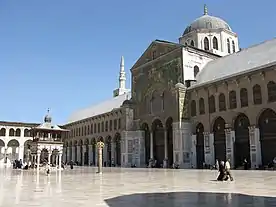 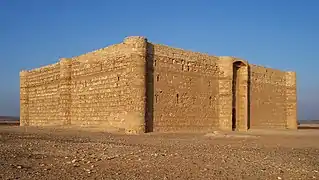 Top: Dome of the Rock (688–692); Middle: Great Mosque of Damascus (705–715); Bottom: Qasr Al-Kharanah (7th-8th century) | |
| Years active | 661–750 CE |
|---|---|
| Part of a series on |
| Arabic culture |
|---|
 |
Umayyad architecture developed in the Umayyad Caliphate between 661 and 750, primarily in its heartlands of Syria and Palestine. It drew extensively on the architecture of older Middle Eastern and Mediterranean civilizations including the Sassanian Empire and Byzantine Empire, but introduced innovations in decoration and form.[1][2] Under Umayyad patronage, Islamic architecture began to mature and acquire traditions of its own, such as the introduction of mihrabs to mosques, a trend towards aniconism in decoration, and a greater sense of scale and monumentality compared to previous Islamic buildings.[1][3][4] The most important examples of Umayyad architecture are concentrated in the capital of Damascus and the Greater Syria region, including the Dome of the Rock, the Great Mosque of Damascus, and secular buildings such as the Mshatta Palace and Qusayr 'Amra.[1][2]
Historical background

The Umayyad Caliphate was established in 661 after Ali, the son-in-law of Muhammad, was murdered in Kufa. Muawiyah I, governor of Syria, became the first Umayyad caliph.[5] The Umayyads made Damascus their capital.[6] Under the Umayyads the Arab empire continued to expand, eventually extending to Central Asia and the borders of India in the east, Yemen in the south, the Atlantic coast of what is now Morocco and the Iberian Peninsula in the west.[7] The Umayyads built new cities, often unfortified military camps that provided bases for further conquests. Wasit in present-day Iraq was the most important of these, and included a square Friday mosque with a hypostyle roof.[7]
The empire was tolerant of existing customs in the conquered lands, creating resentment among those looking for a more theocratic state. In 747, a revolution began in Khorasan, in the east.[7] By 750 the Umayyads had been overthrown by the Abbasids, who moved the capital to Mesopotamia. A branch of the Umayyad dynasty continued to rule in Iberia until 1051.[7]
Characteristics
.jpg.webp)
The Umayyads adopted the construction techniques of Byzantine architecture and Sasanian architecture.[8] The reuse of elements from classical Roman and Byzantine art was particularly evident because political power and patronage was centered in Syria, formerly part of the Byzantine (Eastern Roman) Empire.[1] Almost all monuments from the Umayyad period that have survived are in Syria and Palestine.[7] They also often re-used existing buildings. There was some innovation in decoration and in types of building.[7] A significant amount of experimentation occurred as Umayyad patrons recruited craftsmen from across the empire and architects were allowed, or even encouraged, to mix elements from different artistic traditions and to disregard traditional conventions and restraints.[1]
Most buildings in Syria were of high quality ashlar masonry, using large tightly-joined blocks, sometimes with carving on the facade. Stone barrel vaults were only used to roof small spans. Wooden roofs were used for larger spans, with the wood in Syria brought from the forests of Lebanon. These roofs usually had shallow pitches and rested on wooden trusses. Wooden domes were constructed for Al-Aqsa Mosque and the Dome of the Rock, both in Jerusalem.[9] Baked brick and mud brick were used in Mesopotamia, due to lack of stone. Where brick was used in Syria, the work was in the finer Mesopotamian style rather than the more crude Byzantine style.[9]
Umayyad architecture is distinguished by the extent and variety of decoration, including mosaics, wall painting, sculpture and carved reliefs with Islamic motifs.[9] The Umayyads used local workers and architects. Some of their buildings cannot be distinguished from those of the previous regime. However, in many cases eastern and western elements were combined to give a distinctive new Islamic style. For example, the walls at Qasr Mshatta are built from cut stone in the Syrian manner, the vaults are Mesopotamian in design and Coptic and Byzantine elements appear in the decorative carving.[9] While figural scenes were notably present in monuments like Qusayr 'Amra, non-figural decoration and more abstract scenes became highly favoured, especially in religious architecture.[10][11] The horseshoe arch appears for the first time in Umayyad architecture, later to evolve to its most advanced form in al-Andalus.[12]
Dome of the Rock
_02.jpg.webp)
The sanctuary of the Dome of the Rock, standing on the Haram al-Sharif (Temple Mount) in Jerusalem, is the oldest surviving major Islamic building.[7][13] It is also an exceptional monument within the context of Umayyad and wider Islamic architecture, in terms of both its form and function.[2] It was not a mosque but rather a shrine or commemorative monument, likely built to honour ancient religious associations with the site such as the creation of Adam and Abraham's sacrifice. It acquired further layers of meaning over time and became most commonly associated with the "Night Journey" of Muhammad. It was also built as a visual symbol of Islamic dominance and its high dome was likely designed to compete for prominence with the dome of the nearby Christian Church of the Holy Sepulchre.[2][13]
The building followed the design of a Byzantine martyrium.[2][13] It consists of an octagonal structure, inside of which is another octagon formed by piers and columns, and finally an inner circular ring of piers and columns at the center.[13] Although the exterior of the building is now covered in 16th-century Ottoman tiles, both the exterior and interior were originally decorated with lavish mosaics, with the interior mosaics still mostly preserved today.[2][13] The mosaics are entirely aniconic, a characteristic that would continue in later Islamic decoration.[2] The imagery consists of vegetal motifs and other objects such as vases and chalices.[13] The building was also decorated with long inscriptions containing Qur'anic inscriptions chosen to emphasize the superiority of Islam over the preceding Abrahamic religions.[13]
Mosques
General development
The earliest mosques were often makeshift. In Iraq, they evolved from square prayer enclosures.[7] The ruins of two large Umayyad mosques have been found in Samarra, Iraq. One is 240 by 156 feet (73 by 48 m) and the other 213 by 135 metres (699 by 443 ft). Both had hypostyle designs, with roofs supported by elaborately designed columns.[14]
In Syria, the Umayyads preserved the overall concept of a court surrounded by porticos, with a deeper sanctuary, that had been developed in Medina. Rather than make the sanctuary a hypostyle hall, as was done in Iraq, they divided it into three aisles. This may have been derived from church architecture, although all the aisles were the same width.[3] In Syria, churches were converted to mosques by blocking up the west door and making entrances in the north wall. The direction of prayer was south towards Mecca, so the long axis of the building was at right angles to the direction of prayer.[15]
The Umayyads introduced a transept that divided the prayer room along its shorter axis.[3] They also added the mihrab to mosque design.[3] The Prophet's Mosque in Medina built by al-Walid I had the first mihrab, a niche on the qibla wall, which seems to have represented the place where the Prophet stood when leading prayer. This almost immediately became a standard feature of all mosques.[3] The minbar also began appearing in mosques in cities or administrative centers, a throne-like structure with regal rather than religious connotations.[3]
Great Mosque of Damascus
The Great Mosque of Damascus was built by the caliph al-Walid I around 706–715.[6] Some scholars have argued that the first Umayyad version of the al-Aqsa Mosque in Jerusalem, begun by Abd al-Malik (al-Walid's father) and now replaced by later constructions, had a layout very similar to the current Umayyad Mosque in Damascus and that it probably served as a model for the latter.[16][17] The layout remains largely unchanged and some of the decoration has been preserved. The Great Mosque was built within the area of a Roman temenos from the first century.[6] The exterior walls of the earlier building, once a temple of Jupiter and later a church, were retained, although the southern entrances were walled up and new entrances made in the north wall. The interior was completely rebuilt.[18]
The Damascus mosque is rectangular, 157.5 by 100 metres (517 by 328 ft), with a covered area 136 by 37 metres (446 by 121 ft) and a courtyard 122.5 by 50 metres (402 by 164 ft) surrounded by a portico.[6] The prayer hall has three aisles parallel to the qibla wall, a common arrangement in Umayyad mosques in Syria.[6] The court holds a small octagonal building on columns. This was the treasury of the Muslims, perhaps only symbolic, which was traditionally kept in a town's main mosque.[19] The mosque was richly decorated with mosaics and marble. A rich composition of marble paneling covered the lower walls, though only minor examples of the original marbles have survived today near the east gate.[20] The marble window grilles in the great mosque, which diffuse the light, are worked in patterns of interlocking circles and squares, precursors to the arabesque style that would become characteristic of Islamic decoration.[21]
Vast portions of the mosque's walls were decorated with mosaics, of which some original fragments have survived, including some that depict the houses, palaces and river valley of Damascus.[18] Byzantine artisans were reportedly employed to create them, and their imagery reflects a late Roman style.[23][24][25] They reflected a wide variety of artistic styles used by mosaicists and painters since the 1st century CE, but the combined use of all these different styles in the same place was innovative at the time.[26] Similar to the Dome of the Rock, built earlier by Abd al-Malik, vegetation and plants were the most common motif, but those of the Damascus mosque are more naturalistic.[26] In addition to the large landscape depictions, a mosaic frieze with an intricate vine motif (referred to as the karma in Arabic historical sources) once ran around the walls of the prayer hall, above the level of the mihrab.[27] The only notable omission is the absence of human and animal figures, which was likely a new restriction imposed by the Muslim patron.[26] Scholars have long debated the meaning of the mosaic imagery. Some historical Muslim writers and some modern scholars have interpreted them as a representation of all the cities in the known world (or within the Umayyad Caliphate at the time), while other scholars interpret them as a depiction of Paradise.[26]
Other mosques
The Great Mosque of Damascus served as a model for later mosques.[7] Similar layouts, scaled down, have been found in a mosque excavated in Tiberias, on the Sea of Galillee, and in a mosque in the palace of Khirbat al-Minya.[6] The plan of the White Mosque at Ramla differs in shape, and the prayer hall is divided into only two aisles.[lower-alpha 1] This may be explained by construction of underground cisterns in the Abbasid period, causing the original structure to be narrowed.[17]
The Mosque of Sidi Okba near Biskra (present-day Algeria) belongs to a large complex built around the tomb of the governor of Ifriqiya, 'Uqba ibn Nafi' (d. 683). This mosque is one of the oldest in North Africa, though it has been significantly modified in later periods.[30] Its hypostyle layout resembles the early mosques of Medina, with seven naves running parallel to the qibla wall. This type of transverse configuration of the naves is reminiscent of Umayyad or early Medina mosques.[31][32]
Desert palaces

The Umayyads are known for their desert palaces, some new and some adapted from earlier forts. The largest is Qasr al-Hayr al-Sharqi. The palaces were symbolically defended by walls, towers and gates. In some cases the outside walls carried decorative friezes.[9] The palaces would have a bath house, a mosque, and a main castle. The entrance to the castle would usually be elaborate. Towers along the walls would often hold apartments with three or five rooms.[33] These rooms were simple, indicating they were little more than places to sleep.[9] The palaces often had a second floor holding formal meeting rooms and official apartments.[33]
The fortress-like appearance was misleading. Thus Qasr Kharana appears to have arrowslits, but these were purely decorative.[34] The fortress-like plan was derived from Roman forts built in Syria, and construction mostly followed earlier Syrian methods with some Byzantine and Mesopotamian elements. The baths derive from Roman models, but had smaller heated rooms and larger ornate rooms that would presumably have been used for entertainment.[33] The palaces had floor mosaics and frescoes or paintings on the walls, with designs that show both eastern and western influences. One fresco in the bath of Qusayr 'Amra depicts six kings. Inscriptions below in Arabic and Greek identify the first four as the rulers of Byzantium, Spain (at that time Visigothic), Persia and Abyssinia.[35] Stucco sculptures were sometimes incorporated in the palace buildings.[36]
Qasr al-Hayr al-Sharqi is about 100 kilometres (62 mi) northeast of Palmyra on the main road from Aleppo to Iraq. A large walled enclosure 7 by 4 kilometres (4.3 by 2.5 mi) was presumably used to contain domestic animals.[37] A walled madina, or city, contained a mosque, an olive oil press and six large houses. Nearby there was a bath and some simpler houses. According to an inscription dated 728, the caliph provided significant funding for its development.[37] The settlement has a Late Antiquity Mediterranean design, but was soon modified. The madina originally had four gates, one in each wall, but three were soon walled up. The basic layout was formal, but the buildings often failed to comply with the plan.[37] Most of the desert palaces were abandoned after the Umayyads fell from power, and remain as ruins.[9]
Notable examples
Jordan
Syria
- Al-Omari Mosque, Bosra
- Great Mosque of Hama
- Mabrak an-Naqah Mosque, Bosra
- Qasr al-Hayr al-Gharbi
- Qasr al-Hayr al-Sharqi
- Umayyad Mosque, Damascus
Palestine and Israel
- Al-Aqsa Mosque
- Al-Sinnabra
- Dome of the Rock, Jerusalem
- Dome of the Chain, Jerusalem
- Khirbat al-Mafjar
- Khirbat al-Minya
- White Mosque, Ramla
Algeria
Lebanon
- City of Anjar, Lebanon
Saudi Arabia
Tunisia
- Great Mosque of Kairouan or Mosque of Uqba
Gallery
 The Dome of the Chain (Qubbet as-Silsilla) on the Temple Mount in Jerusalem, much renovated version of structure first built in 691
The Dome of the Chain (Qubbet as-Silsilla) on the Temple Mount in Jerusalem, much renovated version of structure first built in 691 Al-Omari Mosque after renovations
Al-Omari Mosque after renovations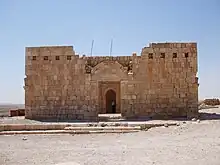 Mosque at Qasr al Hallabat
Mosque at Qasr al Hallabat Qasr al-Hayr al-Gharbi, a castle built by caliph Hisham ibn Abd al-Malik in 727, following Byzantine style.
Qasr al-Hayr al-Gharbi, a castle built by caliph Hisham ibn Abd al-Malik in 727, following Byzantine style. Qasr Kharana in Jordan
Qasr Kharana in Jordan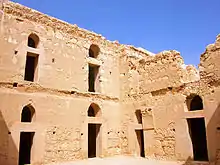 Courtyard of the Qasr Kharana
Courtyard of the Qasr Kharana Qasr al-Hayr al-Sharqi in the Syrian desert
Qasr al-Hayr al-Sharqi in the Syrian desert Qasr Amra in Jordan, from the south
Qasr Amra in Jordan, from the south Ruins of the city of Anjar, Lebanon
Ruins of the city of Anjar, Lebanon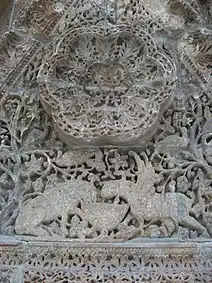 Detail of the Mshatta facade
Detail of the Mshatta facade Central vault of the Qasr Hammam As Sarah bathhouse
Central vault of the Qasr Hammam As Sarah bathhouse Ruins of the Khirbat al-Minya in Galilee
Ruins of the Khirbat al-Minya in Galilee Decoration from Khirbat al-Minya
Decoration from Khirbat al-Minya Umayyad Qasr, Amman, Jordan
Umayyad Qasr, Amman, Jordan
References
Notes
Citations
- 1 2 3 4 5 M. Bloom, Jonathan; S. Blair, Sheila, eds. (2009). "Architecture (III. 661–c. 750)". The Grove Encyclopedia of Islamic Art and Architecture. Oxford University Press. ISBN 9780195309911.
- 1 2 3 4 5 6 7 Tabbaa, Yasser (2007). "Architecture". In Fleet, Kate; Krämer, Gudrun; Matringe, Denis; Nawas, John; Rowson, Everett (eds.). Encyclopaedia of Islam, Three. Brill. ISSN 1873-9830.
{{cite book}}:|journal=ignored (help) - 1 2 3 4 5 6 Ettinghausen, Grabar & Jenkins-Madina 2001, p. 24.
- ↑ M. Bloom, Jonathan; S. Blair, Sheila, eds. (2009). "Mihrab". The Grove Encyclopedia of Islamic Art and Architecture. Oxford University Press. ISBN 9780195309911.
- ↑ Hawting 2002, p. 30.
- 1 2 3 4 5 6 Cytryn-Silverman 2009, p. 49.
- 1 2 3 4 5 6 7 8 9 Petersen 1996, p. 295.
- ↑ Talgam 2004, pp. 48ff.
- 1 2 3 4 5 6 7 Petersen 1996, p. 296.
- ↑ Petersen 1996, pp. 295–296.
- ↑ M. Bloom, Jonathan; S. Blair, Sheila, eds. (2009). "Architecture (III. 661–c. 750)". The Grove Encyclopedia of Islamic Art and Architecture. Oxford University Press. ISBN 9780195309911.
- ↑ Ali 1999, p. 35.
- 1 2 3 4 5 6 7 M. Bloom, Jonathan; S. Blair, Sheila, eds. (2009). "Jerusalem". The Grove Encyclopedia of Islamic Art and Architecture. Oxford University Press. ISBN 9780195309911.
- ↑ Aldosari 2006, p. 217.
- ↑ Petersen 1996, p. 295-296.
- ↑ Grafman & Rosen-Ayalon 1999, pp. 8–9.
- 1 2 Cytryn-Silverman 2009, p. 51.
- 1 2 Holt, Lambton & Lewis 1977, p. 705.
- ↑ Ettinghausen, Grabar & Jenkins-Madina 2001, p. 23.
- 1 2 Ettinghausen, Grabar & Jenkins-Madina 2001, p. 25.
- ↑ Ali 1999, p. 36.
- ↑ Burns 2009, pp. 102.
- ↑ Rosenwein 2014, p. 56.
- ↑ Kleiner 2013, p. 264.
- ↑ M. Bloom, Jonathan; S. Blair, Sheila, eds. (2009). "Damascus". The Grove Encyclopedia of Islamic Art and Architecture. Oxford University Press. ISBN 9780195309911.
- 1 2 3 4 Ettinghausen, Grabar & Jenkins-Madina 2001, p. 26.
- ↑ Flood 1997.
- ↑ Murphy-O'Connor 2008, p. 447.
- ↑ Petersen 1996, p. 245.
- ↑ Une architecture de lumière: Les arts de l'Islam en Algérie. Museum With No Frontiers. 2017. p. 58. ISBN 978-3-902782-22-9.
- ↑ Lafer, Ali. "Sidi 'Uqba (mosque, minaret and tomb)". Discover Islamic Art, Museum With No Frontiers. Retrieved 2022-03-19.
- ↑ "Qantara - Mausoleum and Mosque of Sayyidī (Sidi) 'Uqba". www.qantara-med.org. Retrieved 2022-03-19.
- 1 2 3 Ettinghausen, Grabar & Jenkins-Madina 2001, p. 41.
- ↑ Ettinghausen, Grabar & Jenkins-Madina 2001, p. 39.
- ↑ Holt, Lambton & Lewis 1977, p. 706-707.
- ↑ Petersen 1996, p. 297.
- 1 2 3 Ettinghausen, Grabar & Jenkins-Madina 2001, p. 37.
Sources
- Aldosari, Ali (2006). Middle East, western Asia, and northern Africa. Marshall Cavendish. ISBN 978-0-7614-7571-2. Retrieved 2013-03-17.
- Ali, Wijdan (1999). The Arab Contribution to Islamic Art: From the Seventh to the Fifteenth Centuries. American University in Cairo Press. ISBN 978-977-424-476-6. Retrieved 2013-03-17.
- Burns, Ross (2009) [1992]. The Monuments of Syria: A Guide. I.B. Tauris. ISBN 9781845119478.
- Cytryn-Silverman, Katia (2009-10-31). "The Umayyad Mosque of Tiberias". Muqarnas. BRILL. p. 49. ISBN 978-90-04-17589-1. Retrieved 2013-03-17.
- Enderlein, Volkmar (2011). "Syria and Palestine: The Umayyad Caliphate". In Hattstein, Markus; Delius, Peter (eds.). Islam: Art and Architecture. H. F. Ullmann. pp. 58–87. ISBN 9783848003808.
- Ettinghausen, Richard; Grabar, Oleg; Jenkins-Madina, Marilyn (2001). Islamic Art and Architecture: 650–1250 (2nd ed.). Yale University Press. ISBN 9780300088670.
- Flood, Finbarr Barry (1997). "Umayyad Survivals and Mamluk Revivals: Qalawunid Architecture and the Great Mosque of Damascus". Muqarnas. Boston: Brill. 14: 57–79. doi:10.2307/1523236. JSTOR 1523236.
- Grafman, Rafi; Rosen-Ayalon, Myriam (1999). "The Two Great Syrian Umayyad Mosques: Jerusalem and Damascus". Muqarnas. Boston: Brill. 16: 1–15. doi:10.2307/1523262. JSTOR 1523262.
- Hawting, G. R (2002-01-04). The First Dynasty of Islam: The Umayyad Caliphate AD 661-750. Routledge. p. 30. ISBN 978-0-203-13700-0. Retrieved 2013-03-17.
- Holt, Peter Malcolm; Lambton, Ann K. S.; Lewis, Bernard (1977-04-21). The Cambridge History of Islam. Vol. 2. Cambridge University Press. ISBN 978-0-521-29138-5. Retrieved 2013-03-17.
- Kleiner, Fred (2013). Gardner's Art through the Ages, Vol. I. Cengage Learning. ISBN 9781111786441.
- Murphy-O'Connor, Jerome (2008). The Holy Land: An Oxford Archaeological Guide from Earliest Times to 1700 (5th ed.). Oxford University Press. ISBN 9780199236664.
- Petersen, Andrew (1996). Dictionary of Islamic Architecture. Routledge. ISBN 978-0-203-20387-3. Retrieved 2013-03-16.
- Rosenwein, Barbara H. (2014). A Short History of the Middle Ages. University of Toronto Press. ISBN 9781442606142.
- Talgam, Rina (2004). The Stylistic Origins of Umayyad Sculpture and Architectural Decoration. Vol. 1. Otto Harrassowitz Verlag. ISBN 978-3-447-04738-8. Retrieved 2014-07-13.

